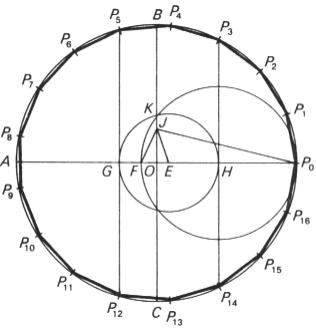Math 594: Algebra II
Professor: David E Speyer
Winter 2017
History (somewhat idealized) and Overview: Since ancient Babylon and Greece, mathematicians have developed methods to solve systems of equations.
In the final years of the eighteenth century, mathematicians began to suspect that their tools were fundamentally incapable of solving certain equations: Gauss (1796)
asserted that the coordinates of a regular heptagon could not be found by straightedge and compass, and Ruffini (1799) gave an
incomplete proof that the roots of a general quintic polynomial could not be computed by basic arithmetic operations.
A few decades after these questions were formally asked, they were answered. Abel (1832) proved Ruffini's claim and Wantzel (1837) proved Gauss's. In 1846, Galois invented
what is now known as Galois theory, which clarified Abel and Wantzel's results and permitted many new ones. From Galois's perspective, Galois theory was a tool to
systematically analyze the process of extracting roots of equations.
In modern mathematics, it is a crucial tool in number theory, algebraic geometry and commutative algebra, as well as still being relevant to its original purpose.
The subject of this course is Galois theory and the topics which lead
up to Galois theory. Specifically, we will discuss group theory and field theory, and then move to the beauties of Galois theory itself. Linear algebra could also be
considered a topic leading into Galois theory. As abstract linear algebra is a prerequisite for this course, we will not cover it as a separate subject, but we will
certainly use linear algebra often and I expect many of you will improve your knowledge of it.
|

|
Course meets: Tuesday and Thursday, 2:30-4:00 PM, 4088
East Hall
Text: Milne's notes Group
Theory and Fields and Galois
Theory.
Office hours My office hours will be 1-2:30 on Wednesdays and 11:30-1:00 on Thursdays.
Professor: David E Speyer, 2844 East Hall, speyer@umich.edu
Course homepage: http://www.math.lsa.umich.edu/~speyer/594
Level: Graduate students and advanced undergraduates.
Prerequisites: Prior exposure to the definitions of groups,
rings, modules and fields. Abstract linear algebra over an arbitrary
field. Principal ideal domains (PIDs) and unique factorization. 513
and 593 are enough background; please speak to me if you have
questions about your background.
Student work expected: I will give problem sets every week, due
on Tuesdays Thursdays.
Homework Policy: You are welcome to consult your class notes
and textbook.
You are welcome to work together with your classmates provided
(1) you list all people and sources who aided you, or whom you aided
and (2) you write-up the solutions independently, in your own language.
If you seek help from mathematicians/math students outside the course,
you should be seeking general advice, not specific solutions, and must
disclose this help. I am, of course, glad to provide help!
I do not intend for you to need to consult other sources, printed or
online. If you do consult such, you should be looking for better/other
expositions of the material, not solutions to specific problems.
In particular, I will assign many standard lemmas which will
be valuable for you to prove for yourselves; searching for other people's proofs of these
results would be self-defeating.
You MAY NOT post homework problems to internet fora seeking
solutions. Although I know of cases where such fora are valuable, and
I participate in some, I feel that they have a major tendency to be
too explicit in their help. You may post questions asking for
clarifications and alternate perspectives on concepts and results we
have covered.
Problem Sets
Group Theory
Problem Set 1, due Tuesday January 17. Also,
skim Chapter 1 in Milne's Group Theory for any concepts you don't
already know; this is material I don't plan to spend much time on.
Problem Set 2, due Tuesday January 24. The material for this week is roughly Milne's Chapter 3.
Problem Set 3, due Tuesday January 31. Milne
puts the Sylow theorems in Chapter 5.
Problem Set 4, due Thursday February 9. Nilpotent and solvable groups is Milne Chapter 6.
Problem Set 5, due Thursday February 16.
Problem Set 6, due Thursday February
23.
Field and Galois theory
Problem Set 7, due Thursday March
16. Also, skim chapter 1 in Milne's Field and Galois Theory for
any concepts you may be missing.
Problem Set 8, due March 23. We have now gone through chapter 2 of Milne and will spend the next two weeks in chapter 3. You
may find these to be helpful references.
Problem Set 9, due March 30.
Problem Set 10, due April 6.
Problem Set 11, due April 13. This is
the last assignment.
Topics covered
All plans for future dates are subject to revision.
January 5: Using symmetries to solve equations. Handouts 1, 2.
Group Theory
January 10: Examples of group filtrations. Handout
January 12: The Jordan-Holder Theorem. Notes from a previous time I taught this
January 17: Direct and semidirect products
January 19: Extensions of groups Handout
January 24: Statement and proof of the Sylow theorems.
January 26: Applications of the Sylow theorems.
January 31: Solvable groups.
February 2: Nilpotent groups.
February 7: The Schur-Zassenhaus theorem — reduction to
abelian groups. Here are some notes of Keith Conrad,
presenting a similar argument.
February 9: The Schur-Zassenhaus theorem — abelian
groups. Here is a write up of the main
computation.
February 14: A taste of group cohomology
February 16: Groups of order < 60 are solvable.
February 20: The simple groups of order 60 and 168.
February 22: The simple groups of order 60 and 168 concluded.
Field and Galois Theory
March 7 Review of polynomials and field extensions
March 9 Constructible numbers
March 14 Splitting fields and automorphisms of fields
March 16 Statement of the main theorem of Galois theory
Mar 21 Examples
Mar 23 Examples
Mar 28 Examples
Mar 30 Solvable extensions
Apr 4 Proof of the main theorem of Galois theory
Apr 6 Inseparable extensions
Apr 11 No class.
Apr 13 Galois groups and covering spaces
Apr 18 Galois groups and number theory
